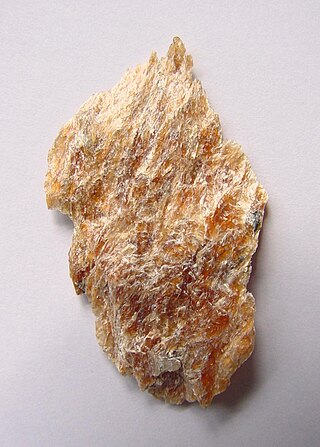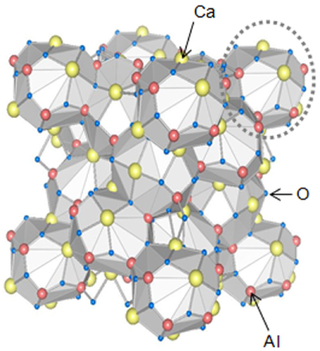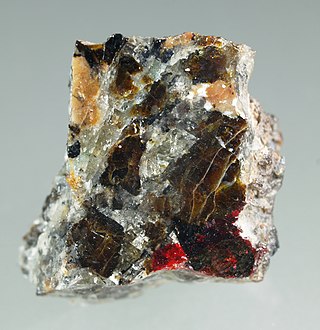Related Research Articles

The name apophyllite refers to a specific group of phyllosilicates, a class of minerals. Originally, the group name referred to a specific mineral, but was redefined in 1978 to stand for a class of minerals of similar chemical makeup that comprise a solid solution series, and includes the members fluorapophyllite-(K), fluorapophyllite-(Na), hydroxyapophyllite-(K). The name apophyllite is derived from the Greek ἀποφυλλίζω apophylliso, meaning "it flakes off", a reference to this class's tendency to flake apart when heated, due to water loss. Exfoliation of apophyllite is also possible by treating it with acids or simply by rubbing it. These minerals are typically found as secondary minerals in vesicles in basalt or other volcanic rocks. A recent change (2008) in the nomenclature system used for this group was approved by the International Mineralogical Association, removing the prefixes from the species names and using suffixes to designate the species. A subsequent nomenclature change approved by the International Mineralogical Association in 2013 renamed the minerals to include both suffixes and prefixes, as shown above.

Bentorite is a mineral with the chemical formula Ca6(Cr,Al)2(SO4)3(OH)12·26H2O. It is colored violet to light violet. Its crystals are hexagonal to dihexagonal dipyramidal. It is transparent and has vitreous luster. It has perfect cleavage. It is not radioactive. Bentorite is rated 2 on the Mohs Scale.

Ettringite is a hydrous calcium aluminium sulfate mineral with formula: Ca6Al2(SO4)3(OH)12·26H2O. It is a colorless to yellow mineral crystallizing in the trigonal system. The prismatic crystals are typically colorless, turning white on partial dehydration. It is part of the ettringite-group which includes other sulfates such as thaumasite and bentorite.

Ye'elimite is the naturally occurring form of anhydrous calcium sulfoaluminate, Ca
4(AlO
2)
6SO
4. It gets its name from Har Ye'elim in Israel in the Hatrurim Basin west of the Dead Sea where it was first found in nature by Shulamit Gross, an Israeli mineralogist and geologist who studied the Hatrurim Formation.

Portlandite is a hydroxide-bearing mineral typically included in the oxide mineral class. It is the naturally occurring form of calcium hydroxide (Ca(OH)2) and the calcium analogue of brucite (Mg(OH)2).

Yuksporite is a rare inosilicate mineral with double width, unbranched chains, and the complicated chemical formula K4(Ca,Na)14Sr2Mn(Ti,Nb)4(O,OH)4(Si6O17)2(Si2O7)3(H2O,OH)3. It contains the relatively rare elements strontium, titanium and niobium, as well as the commoner metallic elements potassium, calcium, sodium and manganese. As with all silicates, it contains groups of linked silicon and oxygen atoms, as well as some associated water molecules.

Chlormayenite (after Mayen, Germany), Ca12Al14O32[☐4Cl2], is a rare calcium aluminium oxide mineral of cubic symmetry.
Alluaivite is a rare mineral of the eudialyte group, with complex formula written as Na19(Ca,Mn)6(Ti,Nb)3Si26O74Cl·2H2O. It is unique among the eudialyte group as the only titanosilicate (other representatives of the group are usually zirconosilicates). The two dual-nature minerals of the group, being both titano- and zirconosilicates, are labyrinthite and dualite. They both contain alluaivite module in their structures. Alluaivite is named after Mt. Alluaiv in Lovozero Tundry massif, Kola Peninsula, Russia, where it is found in ultra-agpaitic, hyperalkaline pegmatites.
The Hatrurim Formation or Mottled Zone is a geologic formation with outcrops all around the Dead Sea Basin: in the Negev Desert in Israel, in the Judaean Desert on the West Bank, and in western Jordan. It includes late Cretaceous to Eocene aged impure limestone along with coal bearing chalk and marl. The rocks have been subjected to pyrometamorphism resulting from combustion of contained or underlying coal or hydrocarbon deposits. The formation is named for exposures in the Hatrurim Basin which lies west of the Dead Sea.
Larnite is a calcium silicate mineral with formula: Ca2SiO4. It is the calcium member of the olivine group of minerals.
Labyrinthite is a very rare mineral of the eudialyte group. When compared to other species in the group, its structure is extremely complex - with over 100 sites and about 800 cations and anions - hence its name, with its complexity expressed in its chemical formula (Na,K,Sr)35Ca12Fe3Zr6TiSi51O144(O,OH,H2O)9Cl3. The formula is simplified as it does not show the presence of cyclic silicate groups. Complexity of the structure results in symmetry lowering from the typical centrosymmetrical group to R3 space group. Other eudialyte-group representatives with such symmetry lowering include aqualite, oneillite, raslakite, voronkovite. Labyrinthite is the second dual-nature representative of the group after dualite and third with essential titanium after dualite and alluaivite.

Rastsveatevite is a rare mineral of the eudialyte group with the chemical formula Na27K8Ca12Fe3Zr6Si4[Si3O9]4[Si9O27]4(O,OH,H2O)6Cl2. Its structure is modular. It is only the third member of the group after andrianovite and davinciite with essential (site-dominating) potassium. Potassium and sodium enter both N4 and M2 sites. The mineral is named after Russian crystallographer Ramiza K. Rastsvetaeva.
Aradite is a very rare mineral with formula BaCa6[(SiO4)(VO4)](VO4)2F. Aradite and its phosphorus-analogue, zadovite, were found in paralavas (rocks formed due to pyrometamorphism) of the Hatrurim Formation. Both aradite and zadovite have structures similar to that of nabimusaite. Structure of all three minerals is related to that of hatrurite.
Zadovite is an extremely rare mineral with formula BaCa6[(SiO4)(PO4)](PO4)2F. Together with its vanadium-analogue, aradite, zadovite occur in paralavas (type of pyrometamorphic rocks). Both minerals have structures similar to nabimusaite, and these three minerals occur in the Hatrurim Formation of Israel. Structure of all three minerals is related to that of hatrurite. Minerals combining barium, phosphorus and silicon together are scarce.

Gurimite is a rare mineral with formula Ba3(VO4)2. It is a simple barium vanadate, one of the most simple barium minerals known. It is named after its type locality - Gurim anticline in Israel. It has formed in the rocks of the Hatrurim Formation. Gurimite's stoichiometry is similar to that of copper vanadates mcbirneyite and pseudolyonsite. An example of other barium vanadate mineral is tokyoite.
Dargaite is a rare mineral with formula BaCa12(SiO4)4(SO4)2O3. It is the barium-analogue of nabimusaite, also differing from it in the lack of fluorine. It is one of many recently approved new minerals coming from the Hatrurim complex. Dargaite, as nabimusaite, is trigonal (space group R-3m).
Hexacelsian is a rare barium silicate mineral with the formula BaAl2Si2O8. It was discovered in the Hatrurim Basin in Israel, where the Hatrurim Formation of rocks formed due to exposed pyrometamorphism.

Lamprophyllite is a rare, but widespread mineral Ti-silicate mineral usually found in intrusive agpasitic igneous rocks. Yellow, reddish brown, Vitreous, Pearly.

Shulamit Gross was an Israeli mineralogist and geologist who studied the Hatrurim Formation.
References
- ↑ Warr, L.N. (2021). "IMA–CNMNC approved mineral symbols". Mineralogical Magazine. 85 (3): 291–320. Bibcode:2021MinM...85..291W. doi:10.1180/mgm.2021.43. S2CID 235729616.
- 1 2 3 4 5 6 7 Galuskin, E.V., Gfeller, F., Armbruster, T., Galuskina, I.O., Vapnik, Y., Murashko, M., Włodyka, R., and Dzierżanowski, P., 2015. New minerals with a modular structure derived from hatrurite from the pyrometamorphic Hatrurim Complex. Part I. Nabimusaite, KCa12(SiO4)4(SO4)2O2F, from larnite rocks of Jabel Harmun, Palestinian Autonomy, Israel. Mineralogical Magazine 79(5), 1061-1072
- ↑ "Nabimusaite: Nabimusaite mineral information and data". Mindat.org. Retrieved 2016-03-02.
- ↑ Galuskin, E.V., Gfeller, F., Galuskina, I.O., Pakhomova, A., Armbruster, T., Vapnik, Y., Włodyka, R., Dzierżanowski, P., and Murashko, M., 2015. New minerals with a modular structure derived from hatrurite from the pyrometamorphic Hatrurim Complex. Part II. Zadovite, BaCa6[(SiO4)(PO4)](PO4)2F and aradite, BaCa6[(SiO4)(VO4)](VO4)2F, from paralavas of the Hatrurim Basin, Negev Desert, Israel. Mineralogical Magazine 79(5), 1073-1087
- ↑ "Nabimusaite: Nabimusaite mineral information and data". Mindat.org. Retrieved 2016-03-02.
- ↑ "Nabimusaite: Nabimusaite mineral information and data". Mindat.org. Retrieved 2016-03-02.